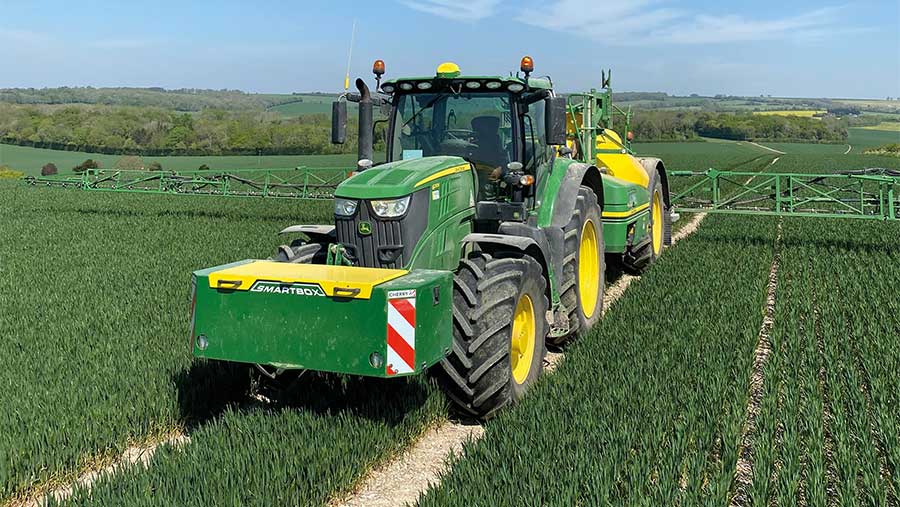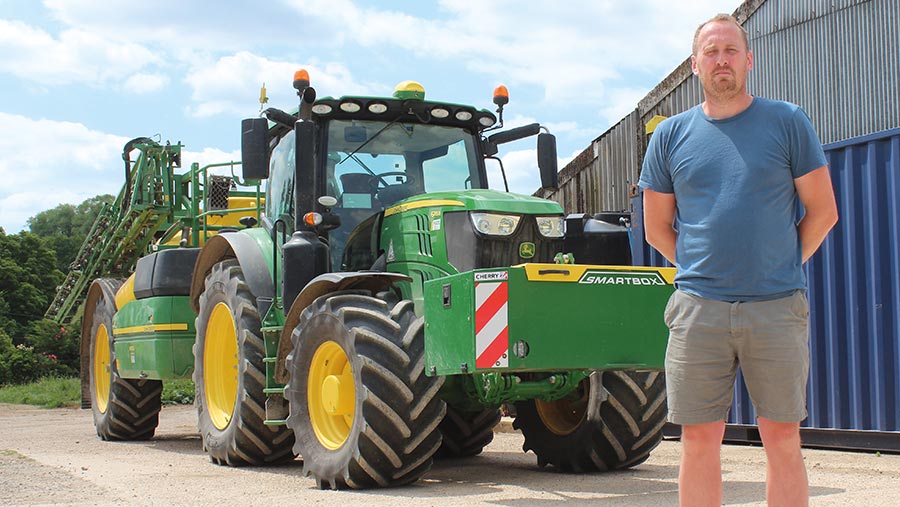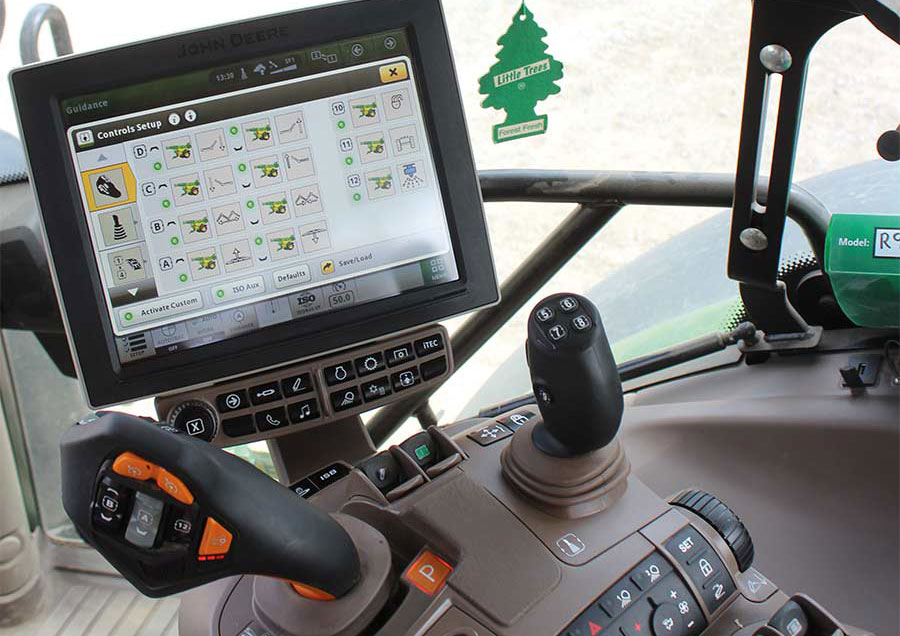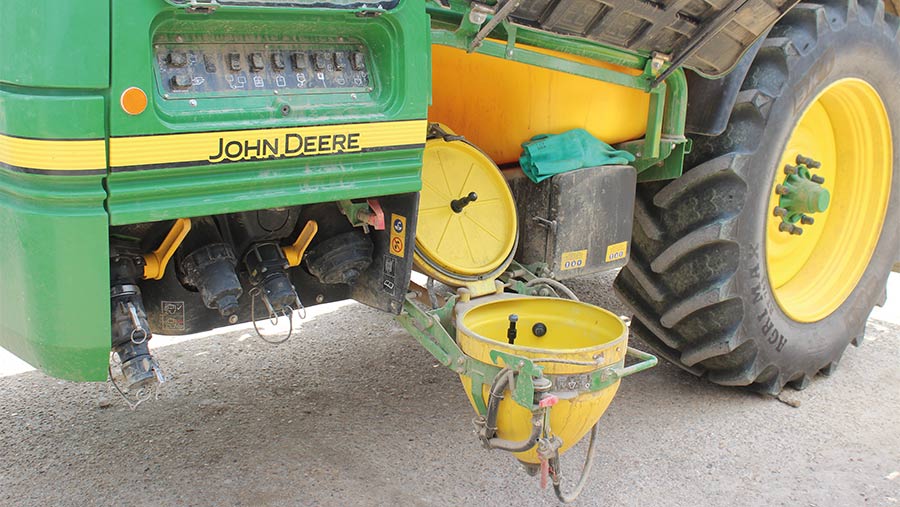Driver’s view: Tristan Newens’ trailed John Deere R952i sprayer
 Trailed JD R952i
Trailed JD R952i Tristan Newens was the only 2020 Farm Sprayer Operator of the Year finalist running a trailed sprayer.
He explains why he made the switch away from a self-propelled and how his John Deere R952i has performed in the field.
See also: Driver’s view: Beds farmer rates his trailed Horsch Leeb sprayer
Farm facts
- Operator Tristan Newens
- Company Windmill Down Farm, Newton Valence, Hampshire
- Area 930ha, mainly chalk
- Crops Winter and spring barley, oilseed rape, winter wheat, winter and spring beans
- Sprayer R952i Powrspray, pulled by 6215R
What sprayer are you using?
A John Deere R952i. I was set on getting a trailed machine when the time came to replace our Bateman RB35, which had clocked 9,000 hours.
The primary reason for the switch away from a self-propelled was financial. They are mega money – we would have had to spend roughly £225,000 on a replacement and run it for 10 years to make it pay.

Tristan Newens
Comparatively, the trailed Deere came in at under £100,000. That left plenty of change to invest in a tractor, so we traded in our 6170R for a 6215R, slimming down the fleet in the process.
The advantage is that, as well as the 800 hours of spraying, it can do another 400 hours on a cultivator or grain trailer.
We tried out a Horsch Leeb GS6000 and the boom on it was awesome, but Farols at Midhurst offered a competitive deal and it simplified the process of getting the sprayer and tractor to talk to one another.
We decided to settle with the 5,200-litre version – the bigger 6,200-litre was a lot more money, despite being on the same chassis, and we only have a couple of fields larger than 40ha. The extra tonne when fully loaded wouldn’t have been ideal for our hilly ground, either.
Going for a John Deere meant we could stick with Starfire guidance, too – in my opinion, it’s the best around.
We currently run the basic version and never have any misses but, at some point, we’ll make the £6,000-a-tractor upgrade to RTK for spraying, drilling and fertiliser spreading.
Because we have the premium spec with Commandpro joystick, I can set up all the spray functions to work through the tractor’s built-in controls and screen. The end result is that it’s a pretty similar driving style to a self-propelled.
The other motivation for the change was comfort. The Bateman could only manage 35kph and the ride, with the driver’s seat above the axle, had taken its toll on my back.
It wasn’t helped by the fact that we cover five separate farms from Alton to Finchdean, near Portsmouth, which is a 30-mile commute.
It means I can leave the sprayer at one of the other farms and cruise home in the tractor at the end of the day. I also get all the perks of the Deere cab – it’s quiet, comfortable and has decent air conditioning.
What extras did you get?
Farols chucked an extra 10.8in John Deere touchscreen into the package, so I can have the main display for Autotrac guidance and the other showing sprayer details, such as application rate, which run through the Isobus connection.
We already had the twin-screen setup on the drilling tractor, and it saves faffing around with half-sized displays and toggling between pages.
The system has automatic nine-section control, which can also be used for our Amazone fertiliser spreader. It can be set up for variable-rate fertiliser, too, which we do on about 160ha of our land.

Deere’s standard spec is pretty good, so we didn’t have to add too many extras. It all runs through the tractor’s load-sensing Power Beyond hydraulics, rather than a pto, so there is no need to have the engine revving hard.
I tend to have it running at 1,500rpm, which is enough to maintain the oil flow. On flat ground, it means fuel consumption can be as low as 8 litres/hour, though it climbs to nearer 40 litres/hour on the hills.
The sprayer also came with a greaseable ball-and-cup Dromone hitch, which has completely eliminated drawbar slam and is so smooth it feels like a pivot-steer loader.
It’s a simple retrofit design that fits around the standard telescopic hook, so can be removed for towing trailers in a matter of seconds.
We considered speccing the option of shutting the 30m booms down to 24m but, realistically, we haven’t got the capacity to take on extra contract spraying work that would have justified the outlay.
Sprayer spec – John Deere R952i Powrspray
- List price £114,661 (6215R list price £183,080)
- Year 2019
- Tractor John Deere 6215R
- Power 237hp
- Transmission Autopowr CVT
- Road speed 50kph
- Tank size 5,200 litres
- Rinse tank 620 litres
- Pump 1,200 litres/min (optional fast-fill), 750 litres/min (spraying)
- Nozzles Twin line – single and quad outlet
- Auto shut-off Nine-section
- Boom levelling John Deere tri-sensor Terrain Command
- Guidance Starfire1
- Boom width 30m tri-fold
- Wheel sizes 620/70 R42 BKT (tractor currently runs 650s)
- Average daily output 100ha/day
How has it performed?
We’ve now had it for a year and it has proved to be money well spent.
The only breakdowns we’ve had have been two blown O-ring pump seals, and both were fixed in a day. It’s something that is bound to happen periodically with liquid fert in the workload, so I pressure wash the booms regularly to avoid too many problems.
The filling system has been a particular improvement over the Bateman. Deere’s Powrspray function allows me to pause the tank filling and redirect the incoming fresh water through the induction hopper.
Typically, I fill three-quarters of the tank, then start putting in the chemical, which leaves plenty of time to get sorted with cans. Our newest spray tank also has a 3in coupling, so I can fill up in five minutes. That means downtime on liquid fert jobs is minimal.
Though trailed sprayers have a reputation for causing a bit of a mess, I haven’t yet got stuck and we have a wet farm. It runs on 620 BKTs, which help it travel nicely without tinkering with the pressures.

The tractor is fitted with 650s, but next time around we’ll spec it with the same tyre size as the sprayer. The crop recovers fine – in fact, it can be difficult to find the wheelings in some of the spring crops when I come to make another pass.
The lowest point is the tractor drawbar and Deere’s levelling system on the variable-geometery booms has proved just as good as the Norac kit. The middle sensor reads outside the tramline, which helps give a more accurate reading.
However, I decided to make extra mudguards from £50 sheets of rubber matting – the type used on the floor of horse stables.
On the sprayer, they bolt to the brackets that carry the lights, which has stopped mud flicking onto the boom and blocking the nozzles. The set for the tractor is carried on a metal subframe that fits to the three-point linkage.
What are your go-to nozzles?
Twin-line system: single outlet on line one, quad outlet on line two.
- General spraying Hypro Guardian Air 110-035
- Perfect conditions Syngenta Defy 3D
- Pre-emergence Guardian Air Twin 110-06 Grey
- Liquid fert Hypro ESI cap white / blue 03
What’s your spray store and fill-up area like?
I try to keep things pretty simple. We have five sites, and each has its own water supply, though I always carry my own filling pipes and spares to each one in a front-mounted Cherry box.
At our main 360ha base near Alton, we’re also looking at setting up a rainwater-harvesting system.
At each farm, there’s a 10,000-litre water tank – enough for about 200ha. This gives the water supply a decent head start, which is important, as I can easily work quicker than a 2cm pipe with relatively low pressure can refill the tank.
As for cleaning out, we don’t have biobeds and I haven’t used All Clear tank cleaner for three years – I prefer to plan my spray day to suit washes.
Our next step is to go paperless with spray records. I’ll have an iPad in the tractor that will automatically upload the information to Gatekeeper and save a load of office time. Frustratingly, Gatekeeper and JD Link aren’t very easy to get talking to each other.
Likes and gripes
Likes
- Travels smoothly
- Slick fill-up system
Gripes
- Gatekeeper and JD link don’t talk
- Liquid fert eats spray pump O rings

